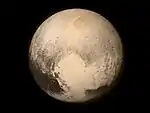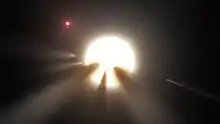HD 219134
HD 219134 (also known as Gliese 892 or HR 8832) is a main-sequence star in the constellation of Cassiopeia. It is smaller and less luminous than our Sun, with a spectral class of K3V, which makes it an orange-hued star. HD 219134 is relatively close to our system, with an estimated distance of 21.25 light years. This star is close to the limit of apparent magnitude that can still be seen by the unaided eye. The limit is considered to be magnitude 6 for most observers. This star has a magnitude 9.4 optical companion at an angular separation of 106.6 arcseconds.[10]
 Star HD 219134 (circled) lies just off the "W" shape of the constellation Cassiopeia. | |
| Observation data Epoch J2000 Equinox J2000 | |
|---|---|
| Constellation | Cassiopeia |
| Right ascension | 23h 13m 16.97632s[1] |
| Declination | +57° 10′ 06.0823″[1] |
| Apparent magnitude (V) | 5.574[2] |
| Characteristics | |
| Spectral type | K3V[3] |
| U−B color index | +0.902[2] |
| B−V color index | +0.983[2] |
| Variable type | Suspected[4] |
| Astrometry | |
| Radial velocity (Rv) | –18.5[5] km/s |
| Proper motion (μ) | RA: +2075.07±0.33[1] mas/yr Dec.: +295.45±0.25[1] mas/yr |
| Parallax (π) | 152.76 ± 0.29[1] mas |
| Distance | 21.35 ± 0.04 ly (6.55 ± 0.01 pc) |
| Absolute magnitude (MV) | 6.46[6] |
| Details | |
| Mass | 0.81±0.03[7] M☉ |
| Radius | 0.778±0.005[7] R☉ |
| Luminosity | 0.2646[7] L☉ |
| Surface gravity (log g) | 4.567±0.018[7] cgs |
| Temperature | 4699[7] K |
| Metallicity [Fe/H] | +0.11 (± 0.04)[7] dex |
| Rotational velocity (v sin i) | 6.94[8] km/s |
| Age | 11.0[7] Gyr |
| Other designations | |
| Database references | |
| SIMBAD | data |
Planetary system
HD 219134 has a system of 6 exoplanets. The innermost planet, HD 219134 b, is a rocky super-Earth based on size (1.6 times the size of Earth), and density (6.4 grams per cubic cm).[11][12] This and three additional exoplanets; one super-Earth (designated c and later found to be rocky as well), one Neptunian world (d), and one Jovian world (e); were deduced using HARPS-N radial velocity data by Motalebi et al. in 2015.[13][14] Two months later, Vogt et al. published a paper on this system which found a 6-planet solution, with planets b & c corresponding to those in Motalebi et al., e & g corresponding to Motalebi's d & e, and d & f being new planets.[15][note 1][16] A total of four independent studies have been done regarding the planetary system of HD 219134, with some of their results conflicting with each other. As of March 2017, the star is known to have at least 5 planets, with two of them (HD 219134 b and c) known to be transiting, rocky super-Earths. The previously reported planets HD 219134 g and e/h were not reported in following HARPS-N analyses in March 2017 by Gillon et al.[17][18]
| Companion (in order from star) |
Mass | Semimajor axis (AU) |
Orbital period (days) |
Eccentricity | Inclination | Radius |
|---|---|---|---|---|---|---|
| b | 4.74±0.19 M⊕ | 0.03876±0.00047 | 3.092926±0.000010 | 0 (fixed) | 85.05±0.09° | 1.602±0.055 R⊕ |
| c | 4.36±0.22 M⊕ | 0.06530±0.00080 | 6.76458±0.00033 | 0.062±0.039 | 87.28±0.10° | 1.511±0.047 R⊕ |
| f | >7.30±0.40 M⊕ | 0.1463±0.0018 | 22.717±0.015 | 0.148±0.047 | — | — |
| d | >16.17±0.64 M⊕ | 0.2370±0.0030 | 46.859±0.028 | 0.138±0.025 | — | — |
| g | >11±1 M⊕ | 0.3753±0.0004 | 94.2±0.2 | 0 | — | — |
| h (e) | >108±6 M⊕ | 3.11±0.04 | 2247±43 | 0.06±0.04 | — | — |
References
- van Leeuwen, F. (November 2007), "Validation of the new Hipparcos reduction", Astronomy and Astrophysics, 474 (2): 653–664, arXiv:0708.1752, Bibcode:2007A&A...474..653V, doi:10.1051/0004-6361:20078357, S2CID 18759600.
- Oja, T. (August 1986), "UBV photometry of stars whose positions are accurately known. III", Astronomy and Astrophysics Supplement Series, 65 (2): 405–409, Bibcode:1986A&AS...65..405O.
- Frasca, A.; et al. (December 2009), "REM near-IR and optical photometric monitoring of pre-main sequence stars in Orion. Rotation periods and starspot parameters", Astronomy and Astrophysics, 508 (3): 1313–1330, arXiv:0911.0760, Bibcode:2009A&A...508.1313F, doi:10.1051/0004-6361/200913327, S2CID 118361131.
- Kukarkin, B. V.; et al. (1981), "Nachrichtenblatt der Vereinigung der Sternfreunde e.V. (Catalogue of suspected variable stars)", Nachrichtenblatt der Vereinigung der Sternfreunde E.V. (1981), Moscow: Academy of Sciences USSR Shternberg: 0, Bibcode:1981CSV...C......0K.
- Wielen, R.; et al. (1999), "Sixth Catalogue of Fundamental Stars (FK6). Part I. Basic fundamental stars with direct solutions", Veröff. Astron. Rechen-Inst. Heidelb, Astronomisches Rechen-Institut Heidelberg, 35 (35): 1, Bibcode:1999VeARI..35....1W.
- Holmberg, J.; et al. (July 2009), "The Geneva-Copenhagen survey of the solar neighbourhood. III. Improved distances, ages, and kinematics", Astronomy and Astrophysics, 501 (3): 941–947, arXiv:0811.3982, Bibcode:2009A&A...501..941H, doi:10.1051/0004-6361/200811191, S2CID 118577511.
- "HD 219134". exoplanetarchive.ipac.caltech.edu. Retrieved 2017-12-24.
- Martínez-Arnáiz, R.; et al. (September 2010), "Chromospheric activity and rotation of FGK stars in the solar vicinity. An estimation of the radial velocity jitter" (PDF), Astronomy and Astrophysics, 520: A79, arXiv:1002.4391, Bibcode:2010A&A...520A..79M, doi:10.1051/0004-6361/200913725, S2CID 43455849.
- "HR 8832". SIMBAD. Centre de données astronomiques de Strasbourg. Retrieved 2012-04-08.
- Eggleton, P. P.; Tokovinin, A. A. (September 2008), "A catalogue of multiplicity among bright stellar systems", Monthly Notices of the Royal Astronomical Society, 389 (2): 869–879, arXiv:0806.2878, Bibcode:2008MNRAS.389..869E, doi:10.1111/j.1365-2966.2008.13596.x, S2CID 14878976.
- "PIA19832: Location of Nearest Rocky Exoplanet Known". NASA. 30 July 2015. Retrieved 30 July 2015.
- Chou, Felicia; Clavin, Whitney (30 July 2015). "NASA's Spitzer Confirms Closest Rocky Exoplanet". NASA. Retrieved 31 July 2015.
- Motalebi, F.; et al. (December 2015). "The HARPS-N Rocky Planet Search. I. HD 219134 b: A transiting rocky planet in a multi-planet system at 6.5 pc from the Sun". Astronomy & Astrophysics. 584: A72. arXiv:1507.08532. Bibcode:2015A&A...584A..72M. doi:10.1051/0004-6361/201526822. S2CID 45652878.
- "Cassiopeia's Hidden Gem". Harvard. 30 July 2015. Retrieved 30 July 2015.
- Vogt, Steven S.; et al. (November 2015). "Six Planets Orbiting HD 219134". The Astrophysical Journal. 814 (1): 12. arXiv:1509.07912. Bibcode:2015ApJ...814...12V. doi:10.1088/0004-637X/814/1/12. S2CID 45438051.
- Johnson, Marshall C.; et al. (April 2016). "A 12-year Activity Cycle for the Nearby Planet Host Star HD 219134". The Astrophysical Journal. 821 (2): 74. arXiv:1602.05200. Bibcode:2016ApJ...821...74J. doi:10.3847/0004-637X/821/2/74.
- Gillon, Michaël; et al. (2017). "Two massive rocky planets transiting a K-dwarf 6.5 parsecs away". Nature Astronomy. 1. 0056. arXiv:1703.01430. Bibcode:2017NatAs...1E..56G. doi:10.1038/s41550-017-0056. S2CID 56075932.
- http://backalleyastronomy.blogspot.com/2017/04/hd-219134-scorecard-5-planets-2.html?m=1
Notes
- The NASA Exoplanet Archive redesignated Vogt's d & f as f & g for consistency with Motalebi et al., and initially incorrectly listed Vogt's g as a separate planet from Motalebi's e due to the difference in reported parameters, introducing the designation h for it. The Exoplanet Archive designations have been used in subsequent papers on this system. (See also the Johnson et al. 2016 reference.)
External links
- "BD+56 2966 / HR 8832". SolStation. Retrieved November 7, 2005.


